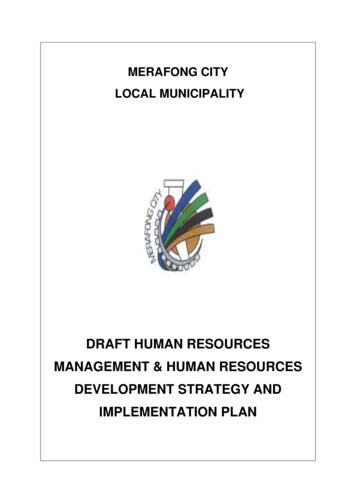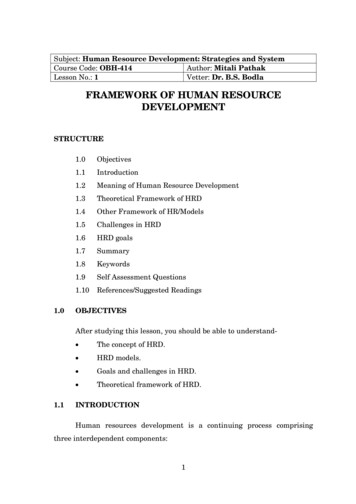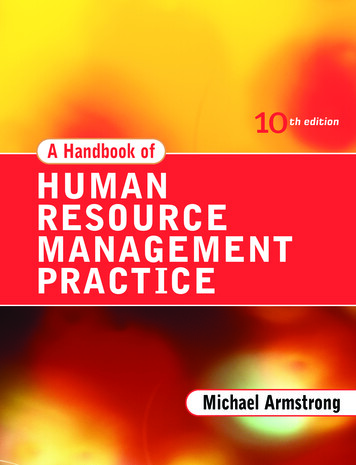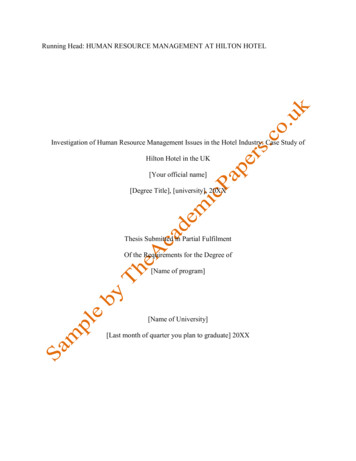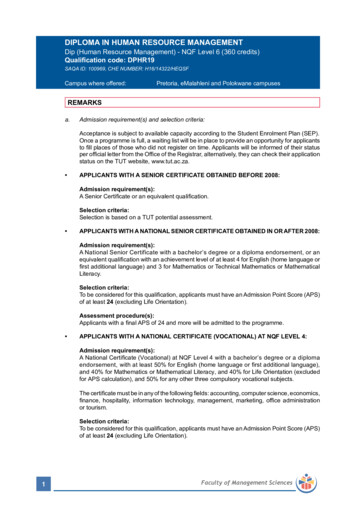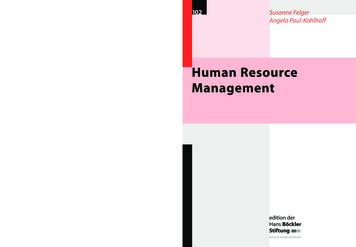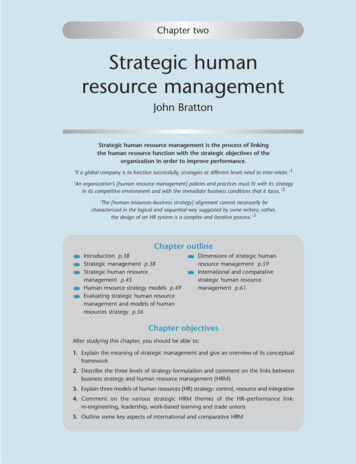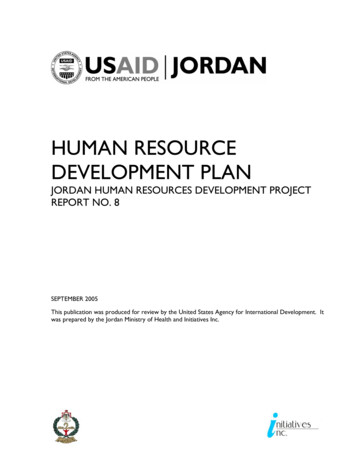
Transcription
HUMAN RESOURCEDEVELOPMENT PLANJORDAN HUMAN RESOURCES DEVELOPMENT PROJECTREPORT NO. 8SEPTEMBER 2005This publication was produced for review by the United States Agency for International Development. Itwas prepared by the Jordan Ministry of Health and Initiatives Inc.
ACKNOWLEDGEMENTSThe HRDP team wishes to recognize the important contributions to all the work conducted underproject over the last year of the four MOH Technical Counterparts, namely: Dr Osama Samawi, Dr SafaQusoos, Dr Salah Diab, and Dr. Mohamed Al Ta’rawneh. These individuals provided continuousguidance and advice to the HRDP team. They participated in all the analyses carried out. They reviewedall reports and provided helpful suggestions for improvement. They facilitated the working groupsthroughout the Strategic Projections Workshop. Above all, they ensured that the work conductedunder the HRDP was known and understood by other MOH managers.The HRDP team also gratefully acknowledges the assistance given by the HRDP AdministrativeCounterpart, Dr. Taher Abu Al-Samen. Dr Taher facilitated all communication between the HRDP andthe MOH, assisted in arranging for meetings with MOH officials, and ensured that the numerousnecessary letters of introduction and invitation to both MOH officers and other organizationsparticipating in the work were disseminated promptly.HR DEVELOPMENT PLAN, JORDAN HUMAN RESOURCES PROJECT (REPORT #8)i
LIST OF ABBREVIATIONSAsst. .AssistantFTE .Full Time Equivalent Staff MemberGP.General (Medical) PractitionerHC.Health CenterHR .Human ResourcesHRDP.Human Resources Development ProjectHRM.Human Resource ManagementMOH.Ministry of HealthMOHE.Ministry of Higher EducationNGO.Non-Governmental OrganizationPHC.Primary Health CareRMS .Royal Medical ServicesTech. .TechnicianHR DEVELOPMENT PLAN, JORDAN HUMAN RESOURCES PROJECT (REPORT #8)ii
HUMAN RESOURCEDEVELOPMENT PLANJORDAN HUMAN RESOURCES DEVELOPMENT PROJECTREPORT NO. 8JENNIFER HUDDART, M.B.A.The information contained in this report is the product of an evaluation conducted by Initiatives Inc.The report was prepared under the auspices of the Technical Assistance and Support Contract (TASC2Global Health), implemented by Initiatives Inc. under Task Order No. GHS-I-802-03-00040-00 issued bythe U.S. Agency for International Development. The opinions expressed in this report are those of theindividual authors and do not necessarily represent the views of USAID.Initiatives Inc.376 Boylston Street, Suite 4CBoston MA 02116 USATEL(617) 262-0293FAX (617) 262-2514www.initiativesinc.comDISCLAIMERThe author’s views expressed in this publication do not necessarily reflect the views of the United StatesAgency for International Development or the United States Government.HR DEVELOPMENT PLAN, JORDAN HUMAN RESOURCES PROJECT (REPORT #8)iii
CONTENTSACKNOWLEDGEMENTS .iLIST OF ABBREVIATIONS .iiLIST OF TABLES.vITHE HUMAN RESOURCE DEVELOPMENT PROJECT (HRDP) . 1Goals and Objectives of the HRDP . 1Components of the HRDP . 1Approach Taken . 3Contents of this Final Report. 3IIEXECUTIVE SUMMARIES OF HRDP REPORTS . 4The Human Resources for Health Situation Analysis . 4The Motivation Study . 6The Compensation (Salary and Benefits) Study. 7Assessment of MOH Human Resource Management Policies and Practices .11The Strategic Health Workforce Projections .14Workload-Based Projections of Staffing Need .22III KEY HR ISSUES ARISING FROM THE ANALYSES AND RECOMMENDATIONS FOR ACTION.28Planning of Human Resources.28Monitoring of the Human Resource Situation .28MOH Pre-Service Training.29Non-MOH Pre-Service Training.31General Management .31Human Resources Management .32The Compensation System.32Career Progression.33Recruitment and Retention .34Suggested Priorities for Implementation of Recommendations.35HR DEVELOPMENT PLAN, JORDAN HUMAN RESOURCES PROJECT (REPORT #8)iv
LIST OF TABLESTable 1Products of the HRDP . 2Table 2Distribution of Staff by Place of Work. 4Table 3Distribution of Professions by Place of Work . 4Table 4Annual Loss Rates of Staff from MOH. 5Table 5Annual Graduates from Jordanian Training Programs . 5Table 6Organizations Studied . 8Table 7Benchmarking of Benefits . 9Table 8MOH Salaries as Benchmarked to the Market Levels. 9Table 9Benchmarking Salaries of Specific Positions in Different Entities .10Table 10Human Resource Components Covered by the HRM Assessment.12Table 11Results of the HRM Assessment .13Table 12Baseline and Projected Staff Requirements (FTEs) by Type of Health Center .16Table 13Baseline and Projected Staff Requirements (FTEs) for Public Sector Hospitals.17Table 14Baseline and Projected Staff Requirements (FTEs)for the Central MOH and Health Directorates .18Table 15The Impact of Training Outputs and Attrition on Staff Supply .19Table 162014 Human Resource Supply –Requirements Comparison – Scenario 1 .20Table 17Key Output Indicators - Scenario 1.21Table 18Health Centers Involved in the Study .23Table 19Average Times Taken for Service Delivery .24Table 20Assumptions on Time Spent on Other Duties .25Table 21FTE Staff Required based on Projected PHC Workload 2014 .26Table 22Comparison between Numbers of Staff CurrentlyWorking at Health Centers and the Projected Requirements .27Table 23Required Changes in Training Outputs from MOH Schools.30HR DEVELOPMENT PLAN, JORDAN HUMAN RESOURCES PROJECT (REPORT #8)v
I.THE HUMAN RESOURCEDEVELOPMENT PROJECT(HRDP)COMPONENTS OF THE HRDPGOALS AND OBJECTIVESOF THE HRDPThe work under the HRDP was organizedaround a number of products, each of whichrepresented one component of the project.These products are shown in Table 1.The goal of the Human Resource Assessmentand Development project was to provide theMOH with the information to be able to makedecisions about the future of their humanresources and to have an understanding of theapproaches and the tools which will help themto continue to monitor and plan for theirhuman resources as circumstances change inthe future.The objectives for the project were as follows:1. Assess the adequacy of present staffing ofhealth facilities at primary & comprehensivehealth centers, hospital and governoratelevels.2. Document the distribution andqualifications of managerial, technical &administrative staff within the central MOHand bodies related to supporting thefunctions of the MOH.3. Assess the adequacy of the present trainingcapacity in the country & define the possibleneed for extra facilities and trainers.4. Assess the current employment policies &practices to explore how currentregulations & practices facilitate or hindereffective human resource management.5. Provide MOH with quantitative informationabout the numbers of staff required for fullstaffing of public health facilities and designon the basis a plan which describes thetraining and human resource managementneeds to achieve full staffing over the nextdecade.The HRDP was a one-year project whichcommenced in September 2004.Report No. 1Mapping of the Central MOHThis was a organizational chart of the centralMOH, together with details of the numbers andqualifications of the staff employed in each unit,section, Department and Directorate.Report No.2HR Situation AnalysisThis was an analysis of the current staffingsituation in the health sector in Jordan. Due todifficulties in obtaining data from the RoyalMedical Services and the private health sector,the major focus of the report is the Ministry ofHealth. The analysis provides information onthe number and distribution of 2004 healthfacilities in the country, on the current staffinglevels in each type of facility, on attrition ratesfrom the MOH by profession, and on presentpre-service training outputs from MOH,University and private health traininginstitutions in Jordan.Report No. 3Motivation StudyThis study examined the factors that motivatehealth staff to remain in or leave theiremployment with the MoH, the reasons peopleapply for training in the health professions andwhy graduates of this training may not continueon as health workers in the public service. Therespondents for the study included presentMoH staff in a variety of positions, recentleavers from the MOH (in the last 24 months),students in pre-service training programs in thehealth professions and school aged youth aboutto make decisions regarding their futurecareers.HR DEVELOPMENT PLAN, JORDAN HUMAN RESOURCES PROJECT (REPORT #8)1
Table 1: Products of the HRDPHRDP PRODUCTS2.1. Mapping ofCentral MOHMay 20053.5.MotivationStudyMay 2005Assessment of MOHHRM PracticesMay 2005HR SituationAnalysisFeb 20058. HUMAN RESOURCEDEVELOPMENTPLANAug 20056.Workload Projectionsof Staff DemandAug 2005Report No. 4Salary and Benefits StudyThis study compared MOH salaries and benefitsfor certain benchmarked positions with thosepaid by the private health sector, NGOs andthe Ministry of Education. The objective of thisstudy was to determine the relativecompetitiveness of MOH salaries and benefitsso as to inform decision-making about thepotential to negotiate improvements to aid inmaintaining staff performance and staffretention.Report No. 5Assessment of MOH Human ResourceManagement PracticesA human resources management system thatfunctions effectively can assist the organizationin developing a set of policies, systems and4.Salary & BenefitsStudyMay 20057. Strategic HealthWorkforce ProjectionsJuly 2005practices that provide an environment whichadvances the skills and increases the motivationof staff in order to achieve the highest possiblelevel of performance over time. This assessmentwas carried out to determine the current stageof development of human resourcemanagement policies and practices in the MOHand to identify areas that need attention if theMOH is to improve both staff retention andstaff performance.Report No. 6Workload Projections of Staff DemandThis analysis focused on the workload of staff atgovernment primary health care facilities inJordan and, based on projections of future clientdemand, presented projections of the needs fordoctors and nurses in the health centers. Thereport also compares Jordan’s MOH hospitalHR DEVELOPMENT PLAN, JORDAN HUMAN RESOURCES PROJECT (REPORT #8)2
staffing situation in relation to beds with thesituation reported in several other countries.Report No. 7Strategic Health Workforce ProjectionsIn June 2005, senior representatives from theMOH and other Jordanian institutions thatprovide support and services to the Jordanianhealth sector, prepared 10-year projections offuture staffing and training needs that would beaffordable within projected financial allocationsto the MOH. This report summarizes theapproach taken and the results of thedeliberations.Report No. 8Human Resource Development PlanThis is the current report.APPROACH TAKENAt the start of the project, the SecretaryGeneral was asked to nominate MOH officersto be the technical counterparts to theconsultants. These officers were to provideguidance to the consultants and oversight oftheir work. In addition, one MOH officer was asthe administrative counterpart to theconsultants and was to facilitate all meetings andcommunications between the project and theMOH.Three MOH officers were appointed by theMOH as technical counterparts and one as theadministrative counterpart in September 2004.In January 2005, the project requested oneadditional technical counterpart and the MOHmade this addition.The technical counterparts have been involvedin every step of the project. They providedinvaluable guidance and support throughout theyear’s work and each of the reports was sentfirst to them in draft for their review andcomments before being finalized and formallysubmitted to USAID and the MOH. Theyattended all important meetings, representedthe project when staff members or consultantswere not present, and took leadership duringthe Strategic Health Workforce Projectionsproceedings.CONTENTS OF THIS FINAL REPORTThis final report provides an overview of all thework carried out under the HRDP. Itsummarizes the main findings of each of theanalyses and studies conducted. Based on thesefindings, it then identifies the important humanresource issues that are now facing the MOH. Itthen concludes with recommendations on stepsthat the MOH will need to consider to dealwith these issues.HR DEVELOPMENT PLAN, JORDAN HUMAN RESOURCES PROJECT (REPORT #8)3
II. EXECUTIVE SUMMARIESOF HRDP REPORTSThe one report that is not summarized here isthat of the Mapping of the Central MOH, sincethis is not a report that can be condensed.THE HUMAN RESOURCES FORHEALTH SITUATION ANALYSISThis report is a compilation of informationabout the staffing situation in the MOH at theend of 2004 in relation to the health facilitiesand the population served. It also detailscurrent training programs in the countryoffering basic and post-basic courses in thehealth professions and presents data on intakesand outputs from these programs. A summaryof the key elements of the report is givenbelow.31,000 persons in Amman to one health centerfor 2,170 people in North Badiah Directorate.StaffIn November, 2004 the MOH had a total of 23,934 staff. Of this total number, 23.7% wereancillary staff, 15.7% were qualified nurses andmidwives, 14.8% were administrative staff,13.4% were doctors, 11.9% were unqualifiednurses, 2.0% were dental doctors, and 9.4%were other categories.Table 2 shows the distribution of MOH staff byplace of work. A total of 44.1% of all staff wereworking in hospitals and 32.0% in healthcenters.Table 2: Distribution of Staff byPlace of WorkCentral MOHAl Basheer HospitalOther HospitalsHealth CentersHealth DirectoratesSpecial UnitsHealth FacilitiesIn 2004, there were a total of 9,262 acutehospital beds in Jordan, or one bed for every690 people. Of these total beds, MOHhospitals represented 34.2%, the private sector37.4%, the RMS 19.5%, and the UniversityHospitals 8.9%. The 3,172 MOH acute hospitalbeds were provided through 26 hospitals, witha relatively low average occupancy rate of 65%.There were a total of 687 health centers(comprehensive, primary, village and standalone MCH centers). On a national level, thisrepresented one health center for 8,000 people,although this ranged from one health center for9.0%10.3%34.1%32.0%12.8%2.0%The central MOH employed a total of 2,057staff, representing 9% of total MOH employees.The central MOH plus the Health Directorateoffice staff represented almost 22% of all MOHstaff.Table 3 provides information on the distributionof the different professional categories by placeof work.Table 3: Distribution of Professions by Place of WorkCategory of StaffAll doctorsGPsRegistered NursesMidwivesPharmacistsAsst. PharmacistsLaboratory Techs.HospitalsHealth lthDirectorates4%7%2%10%22%13%15%Central MOH3%1%1%1%27%6%10%HR DEVELOPMENT PLAN, JORDAN HUMAN RESOURCES PROJECT (REPORT #8)4
In relation to the gender of MOH staff, 80% ofthe Obstetric and Gynecology specialist doctorsare male and only 20% are female. A similarpattern is found for all doctors, where 86% aremale and 14% are female. 62% of the registerednurses and 75% of the pharmacists are female.For management staff, only 12% of the seniormanagers and 33% of the middle managers inthe MOH are female,that the net annual increase for the MOH isonly 13.Of the total MOH staff in 2004, 16% of themedical specialists and 12% of the registerednurses were on long leave.The report provides information on the averagenumber of patients per staff member workingday at MOH hospitals and health centers. Inhospitals, the average number of in-patients perday per doctor varies from 0.2 at two hospitalsto a high of 7.3 at the national psychiatrichospital. Similarly, the average number of inpatients per day per qualified nurse ranges from0.2 to 9.1.Losses of StaffThe average loss rates of staff from the MOHbetween 2002 and 2004 are shown in Table 4.Table 4: Annual Loss Ratesof Staff from MOHCategory of StaffLaboratoryTechniciansRegistered NursesOther TechniciansSpecialist DoctorsX Ray 5.7%3.0%Average No.Leaving/Year3222872842332For specialist doctors, where there have beenan average of 121 graduating each year, the netincrease available to work with the MOH, ifthey so choose, is only 37.Workload/Staff MemberFor health centers, the average number ofclients per day for each doctor ranges from ahigh of 54 to a low of 7. For qualified nurses,the range is even more extreme, with theaverage number of patients ranging from a lowof 30 to a high of 323. The report makes thecomment that workload does not appear to betaken into account in the deployment ofavailable staff.TrainingThe number of laboratory technicians leavingthe MOH each year represents 48% of the totalannual number of new graduates.For X-Ray technicians (who are trained only bythe MOH), an average of 23 have been leavingthe MOH each year, compared to an averageannual output from training of 36, which meansThe report provides details of the intakes andoutputs from the different health trainingprograms available in Jordan through the MOH,the public training institutions (universities) andprivate universities and colleges. Table 5presents information on average numbers ofgraduates each year from all the differentinstitutions.Table 5: Annual Graduates from Jordanian Training ProgramsTraining ProgramResident DoctorsMedical InternsDoctorsRegistered NursesAssociate NursesTraining SectorMOHMOHMOHEPrivate UniversitiesMOHEPrivate UniversitiesMOHAverage No. ofGraduates/Year121237162646815HR DEVELOPMENT PLAN, JORDAN HUMAN RESOURCES PROJECT (REPORT #8)5
Training ProgramLaboratory TechniciansAssociate Lab. Techs.X-Ray TechniciansTraining SectorAverage No. ofGraduates/YearMOHEPrivate CollegesMOHEPrivate UniversitiesMOHMOHTHE MOTIVATION STUDYThis study was conducted by the CommunityDevelopment Group (CDG), The studyexamined the factors that motivate health staffto remain in or leave their employment withthe MOH, the reasons people apply for trainingin the health professions and why graduates ofthis training may not continue on as healthworkers in the public service. The respondentsfor the study included present MOH staff,recent leavers from the MOH (in the last 24months), students in pre-service trainingprograms in the health professions and schoolaged youth about to make decisions regardingtheir future careers.Information was collected through acombination of face-to-face interviews withtrainees, telephone interviews with recentleavers and written questionnaires in the case ofMOH staff who were too busy for face-to-faceinterviews. Comments from school-agedstudents were gathered in the form of focusgroup discussions around specific topics. 61students from Amman, Irbid and Karakparticipated in the focus groups. 180 traineesfrom 5 universities, 153 staff from ten MOHhealth facilities around the kingdom and 32recent leavers from MOH took part in thesurvey.4536 Low salaries and allowances Absence of opportunities for promotion Lack of support for training to enableadvancement Long hours of work Too much work Lack of accommodation Lack of child care. Sub-standard equipment Lack of access to needed information. Lack of appreciation and support fromsuperiors Lack of autonomy No participation in decision making.Recommendations made by current MOH staffincluded: Raise staff salaries and allowances (for riskof infection and night duty specifically) sothat total remuneration matches salaries inthe private sector and region. Develop simple, fair and transparent rulesfor promotion devoid of favoritism andnepotism which will motivate staff and makethem feel appreciated for hard work. Make staff training available both for careerdevelopment and refreshing knowledge. Give staff opportunities to raise theirconcerns and interaction withadministration and supervisors should bemore motivational.Current MOH StaffRegarding current MOH staff, they referred totheir strong relationships with their colleaguesand the satisfaction they feel from doing aworthwhile job as reasons for liking their jobs.However, there were numerous reasons forfrustration:67HR DEVELOPMENT PLAN, JORDAN HUMAN RESOURCES PROJECT (REPORT #8)6
Provide accommodation for staff who livefar from their workplaces or are on dutyand provide MOH assistance in housing.Recent Leavers from MOHLeavers resigned from MOH positions becauseof frustration with job conditions including lowsalaries, lack of opportunity for promotions ortraining and heavy workload, combined withknowledge of better job opportunities outsidethe public sector. Most leavers who moved onto new jobs cited increased wages and morecomfortable work environments in their newworkplaces. Their recommendations weresimilar to those of current MOH staff, butfocused on salary issues and interaction withmanagement.TraineesAmong the trainees interviewed, most hadentered the training program because theirTawjihi scores allowed them to do so. Othermotivations for entering the training includedthe strong labor market for the profession,trainees’ personal interest in the health sectorand the incomes they expected to accrue. Theylooked forward to helping those in need,opportunities for higher study and a strong jobmarket, although among their reservationsregarding the health sector was the low socialregard of individuals in health relatedprofessions, especially nurses and X-Raytechnicians.In general, the training met trainees’expectations, with some finding it more difficultthan they had expected. The overridingrecommendation was that there be morepractical training included in the syllabus.With regard to the MOH as an employer, theinformation held by trainees was conflicting anddisparate, belying a shortcoming in the MOH’sdissemination of information about its jobopportunities. Moreover, only 14% of traineesexpressed a desire to work for the MOH uponcompleting their studies.School StudentsStudents who participated in focus groups weremainly focused on passing their Tawjihi examsbefore thinking about their careers. However,their positive perceptions regarding the healthprofession included prestige, the broad base ofknowledge one acquires through work in thehealth sector, the human side of the professionand the availability of job opportunities.Among their negative perceptions of the healthprofessions were the long and expensive studyperiod, the commercialization of the healthsector and the inappropriate social attitudesabout professions such as nursing and healthtechnicians’ work for men.Many students gained information about theMOH through TV spots and advertisingcampaigns. However, perceptions of MOHwork conditions were shaped through directexperience with the MOH or from relativesemployed by the Ministry. Although some wereaware of the recent progressions of the MOH,opportunities for training and the MOH role inserving the poor, there were also negativereports of working conditions from relatives.Again, the lack of information among thesestudents about to enter the work force hindersthe dissipation of widespread negativeperceptions regarding working conditionswithin the MOH.THE COMPENSATION (SALARY ANDBENEFITS) STUDYThere are several indications that the MOH’scompensation plan is causing problems. There isevidence of high employee loss rates, no orlittle differentiation between high and lowperformers, general employee dissatisfactionwith pay practices, decreased individualaccountability, and decreased effort andproductivity.The MOH loses its professional health staff notonly to wealthy, neighboring countries but alsoto other health organizations in Jordan. Thisstudy was conducted to assess how salaries andHR DEVELOPMENT PLAN, JORDAN HUMAN RESOURCES PROJECT (REPORT #8)7
benefits provided by the MOH to its staff(within the context of civil service and labor lawregulations) compare to those provided byother Jordanian employers.The objective of the study, which was carriedout by Deloitte of Jordan, was to assess theMOH compensation plan in relation to its effecton enabling the MOH to: Recruit and retain qualified employees. Increase or maintain morale/satisfaction. Reward and encourage peak performance. Achieve internal and external equity. Reduce turnover and encourage loyalty.The approach for undertaking this assignmentwas based on benchmarking the ministry'scompensation plan with other leading privateand non-governmental entities in Jordan. Theorganizations covered under the study areshown in Table 6.Table 6: Organizations Studied Al Khaldi Medical Center Ibn Al Haitham Hospital Arab Heart Center King Hussein Cancer Center Al Esra Hospital Jordan University Hospital United Nations Works & ReliefAgency (UNRWA) Jordan Red Crescent Jordanian Association for FamilyPlanning & Protection (JAFPP) American Medical ClinicsThe approach taken was to identify the bestpractice in all benefits available in the marketand judged MOH's practice against that bestpractice by using four levels of competitivenessas follows: Extremely Competitive: If MOH practice isbetter than the best practice. Competitive: If MOH practice is equivale
HR DEVELOPMENT PLAN, JORDAN HUMAN RESOURCES PROJECT (REPORT #8) 2 Table 1: Products of the HRDP HRDP PRODUCTS 1. Mapping of Central MOH May 2005 2. HR Situation Analysis Feb 2005 8. HUMAN RESOURCE DEVELOPMENT PLAN Aug 2005 3. Motivation Study May 2005 4. Salary & Benefits Study May 2005 5. Assessment of MOH HRM Practices May 2005 6. Workload .

